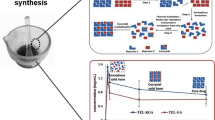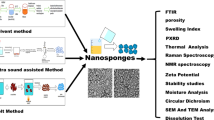Abstract
Polymers have been usually used to retard nucleation and crystal growth in order to maintain supersaturation, yet their roles in inhibition of nucleation and crystal growth are poorly understood. In our work, the polymer-based supersaturation performances and molecular mechanisms of poorly aqueous soluble loratadine were investigated. Two common hydrophilic polymers (hydroxylpropylmethyl cellulose acetate succinate (HPMC-AS) and poly(vinylpyrrolidone-co-vinyl-acetate) (PVP-VA)) were used. It was found that HPMC-AS was a better polymer to prevent drug molecules from aggregation and to maintain the supersaturated state in solution than PVP-VA. The in vitro dissolution experiments showed that HPMC-AS solid dispersions had more rapid release at pH 4.5 and 6.8 media than PVP-VA solid dispersions under the un-sink condition. Moreover, molecular dynamic simulation results showed that HPMC-AS was more firmly absorbed onto a surface of the drug nanoparticles than PVP-VA due to bigger hydrophobic areas of HPMC-AS. Thereby, crystallization process of loratadine was inhibited in the presence of water to provide prolonged stability of the supersaturated state. In conclusion, polymers played a key role in maintaining supersaturation state of loratadine solid dispersions by strong drug–polymer interactions and the hydrophobic characteristic of polymers.








Similar content being viewed by others
References
Stegemann S, Leveiller F, Franchi D, de Jong H, Linden H. When poor solubility becomes an issue: from early stage to proof of concept. Eur J Pharm Sci. 2007;31(5):249–61.
Poornachary SK, Han G, Kwek JW, Chow PS, Tan RBH. Crystallizing micronized particles of a poorly water-soluble active pharmaceutical ingredient: nucleation enhancement by polymeric additives. Cryst Growth Des. 2016;16(2):749–58.
Chen Y, Liu C, Chen Z, Su C, Hageman M, Hussain M, et al. Drug-polymer-water interaction and its implication for the dissolution performance of amorphous solid dispersions. Mol Pharm. 2015;12(2):576–89.
Li CX, Wang HB, Oppong D, Wang JX, Chen JF, Le Y. Excipient-assisted vinpocetine nanoparticles: experiments and molecular dynamic simulations. Mol Pharm. 2014;11(11):4023–35.
Vandecruys R, Peeters J, Verreck G, Brewster ME. Use of a screening method to determine excipients which optimize the extent and stability of supersaturated drug solutions and application of this system to solid formulation design. Int J Pharm. 2007;342(1):168–75.
Yamashita T, Ozaki S, Kushida I. Solvent shift method for anti-precipitant screening of poorly soluble drugs using biorelevant medium and dimethyl sulfoxide. Int J Pharm. 2011;419(1):170–4.
Raina SA, Alonzo DE, Zhang GG, Gao Y, Taylor LS. Impact of polymers on the crystallization and phase transition kinetics of amorphous nifedipine during dissolution in aqueous media. Mol Pharm. 2014;11(10):3565–76.
Kerns EH, Di L. Drug-like properties: concepts, structure design and methods. 1st ed. San Diego: Academic Press; 2008. p. 48–55.
Hughey JR, Keen JM, Miller DA, Brough C, McGinity JW. Preparation and characterization of fusion processed solid dispersions containing a viscous thermally labile polymeric carrier. Int J Pharm. 2012;438(1):11–9.
Berlin M, Przyklenk KH, Richtberg A, Baumann W, Dressman JB. Prediction of oral absorption of cinnarizine—a highly supersaturating poorly soluble weak base with borderline permeability. Eur J Pharm Biopharm. 2014;88(3):795–806.
Trasi NS, Taylor LS. Effect of additives on crystal growth and nucleation of amorphous flutamide. Cryst Growth Des. 2012;12(6):3221–30.
Almeida Sousa L, Reutzel-Edens SM, Stephenson GA, Taylor LS. Supersaturation potential of salt, co-crystal, and amorphous forms of a model weak base. Cryst Growth Des. 2016;16(2):737–48.
Jha PK, Larson RG. Assessing the efficiency of polymeric excipients by atomistic molecular dynamics simulations. Mol Pharm. 2014;11(5):1676–86.
Malaj L, Censi R, Mozzicafreddo M, Pellegrino L, Angeletti M, Gobetto R, et al. Influence of relative humidity on the interaction between different aryl propionic acid derivatives and poly(vinylpyrrolydone) K30: evaluation of the effect on drug bioavailability. Int J Pharm. 2010;398(1):61–72.
Metwally AA, Hathout RM. Computer-assisted drug formulation design: novel approach in drug delivery. Mol Pharm. 2015;12(8):2800–10.
Song W, Quan P, Li S, Liu C, Lv S, Zhao Y, et al. Probing the role of chemical enhancers in facilitating drug release from patches: mechanistic insights based on FT-IR spectroscopy, molecular modeling and thermal analysis. J Control Release. 2016;227:13–22.
Popović G, Cakar M, Agbaba D. Acid-base equilibria and solubility of loratadine and desloratadine in water and micellar media. J Pharm Biomed Anal. 2009;49(1):42–7.
Morris GM, Goodsell DS, Halliday RS, Huey R, Hart WE, Belew RK, et al. Automated docking using a Lamarckian genetic algorithm and an empirical binding free energy function. J Comput Chem. 1998;19(14):1639–62.
Martínez L, Andrade R, Birgin EG, Martínez JM. PACKMOL: a package for building initial configurations for molecular dynamics simulations. J Comput Chem. 2009;30(13):2157–64.
Wang J, Wolf RM, Caldwell JW, Kollman PA, Case DA. Development and testing of a general amber force field. J Comput Chem. 2004;25(9):1157–74.
Salomon-Ferrer R, Götz AW, Poole D, Le Grand S, Walker RC. Routine microsecond molecular dynamics simulations with AMBER on GPUs. 2. Explicit solvent particle mesh Ewald. J Chem Theory Comput. 2013;9(9):3878–88.
Li H, Tan Y, Yang L, Gao L, Wang T, Yang X, et al. Dissolution evaluation in vitro and bioavailability in vivo of self-microemulsifying drug delivery systems for pH-sensitive drug loratadine. J Microencapsul. 2015;32(2):175–80.
Sun DD, Lee P. Probing the mechanisms of drug release from amorphous solid dispersions in medium-soluble and medium-insoluble carriers. J Control Release. 2015;211:85–93.
Cai C, Liu M, Li Y, Guo B, Chang H, Zhang X, et al. A silica-supported solid dispersion of bifendate using supercritical carbon dioxide method with enhanced dissolution rate and oral bioavailability. Drug Dev Ind Pharm. 2016;42(3):412–7.
Ouyang D. Investigating the molecular structures of solid dispersions by the simulated annealing method. Chem Phys Lett. 2012;554:177–84.
Sun M, Wu C, Fu Q, Di D, Kuang X, Wang C, et al. Solvent-shift strategy to identify suitable polymers to inhibit humidity-induced solid-state crystallization of lacidipine amorphous solid dispersions. Int J Pharm. 2016;503(1):238–46.
Li C, Wang JX, Le Y, Chen JF. Studies of bicalutamide-excipients interaction by combination of molecular docking and molecular dynamics simulation. Mol Pharm. 2013;10(6):2362–236.
Acknowledgements
The authors report no declaration of interest. We thank financial support from the National Natural Science Foundation of China (No. 81473164, J1210029). We also thank financial support from Project for New Century Excellent Talents of Ministry of Education (No. NCET-12-1015). The research was financially supported by the Education Department of Liaoning Province (Grant LJQ2015109) and the Scientific Research Foundation for the Returned Overseas Scholars in Shenyang Pharmaceutical University (GGJJ2014101).
Author information
Authors and Affiliations
Corresponding authors
Ethics declarations
Conflict of interest
The authors declare that they have no conflict of interest.
Rights and permissions
About this article
Cite this article
Zhang, S., Sun, M., Zhao, Y. et al. Molecular mechanism of polymer-assisting supersaturation of poorly water-soluble loratadine based on experimental observations and molecular dynamic simulations. Drug Deliv. and Transl. Res. 7, 738–749 (2017). https://doi.org/10.1007/s13346-017-0401-8
Published:
Issue Date:
DOI: https://doi.org/10.1007/s13346-017-0401-8




